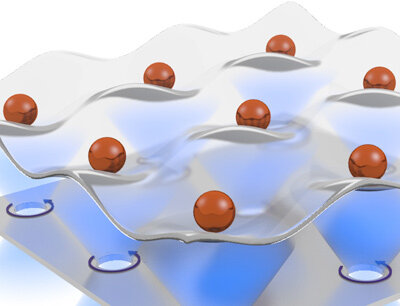Trapping Atoms With Vortices
Image: J.P. Ronzheimer/Max-Planck Institute for Quantum Optics
In Physical Review Letters ERC awardee Oriol Romero-Isart and his colleagues have published a new model for a quantum simulator. In addition to the established techniques based on laser light, they want to establish a new approach based on perforated superconductors and magnetic fields to conduct quantum mechanical experiments.
Trapping and manipulating atoms in optical lattices has been a widely used method for performing quantum mechanical experiments. With this technique, the physicists use several crisscrossing lasers, which create a system of standing waves. In this lattice field or potential, which resembles an egg carton, ultracold atoms are drawn into local minima of the lattice potential, thereby assembling symmetrically. Under these controlled conditions, the researchers are able to experimentally investigate phenomena in solid body systems. Since these phenomena are very complex, a conventional computer simulation of their behaviour soon reaches its limits but in a quantum system of ultracold atoms in optical lattices simulation becomes feasible.
In a recently published article in Physical Review Letters Oriol Romero-Isart and his colleagues from Innsbruck, the Max Planck Institute for Quantum Optics in Garching and the Universitat Autònoma de Barcelona suggest a new experimental approach: The physical theorists propose to pin the atoms to a position solely by using magnetic fields. They use a superconductor that a magnetic field can penetrate only in the form of vortices. The perforated superconducting sheet can be prepared to have one vortex in each hole. The field created by the array of vortices resembles an egg carton, similar to an optical lattice. Ultracold atoms with a magnetic moment tend to move horizontally to the position of the weakest field and assemble in a regular pattern. According to the physicists proposal, another magnetic field has to be placed externally to prevent the atoms from drifting upward. This magnetic field pins the particles at some distance from the surface of the superconductor.
By using magnetic fields, the physicists create a system analogue to optical lattices. The advantage of this new technique is that the distance between the particles can be a lot smaller. Based on this approach, the realized quantum simulators are predicted to be considerably more stable against external disturbances and also faster. In addition, they are able to choose the geometrical arrangement of the traps by choosing the hole placement, which offers a new way to manipulate the lattice properties. “With this approach we could discover properties of ultracold atoms in lattice structures we may not have observed in optical lattices yet,” says Oriol Romero-Isart. Since October, the physicist has been Professor at the University of Innsbruck and Junior Research Director at the Insitute for Quantum Optics and Quantum Information of the Austrian Academy of Sciences.
Links:

